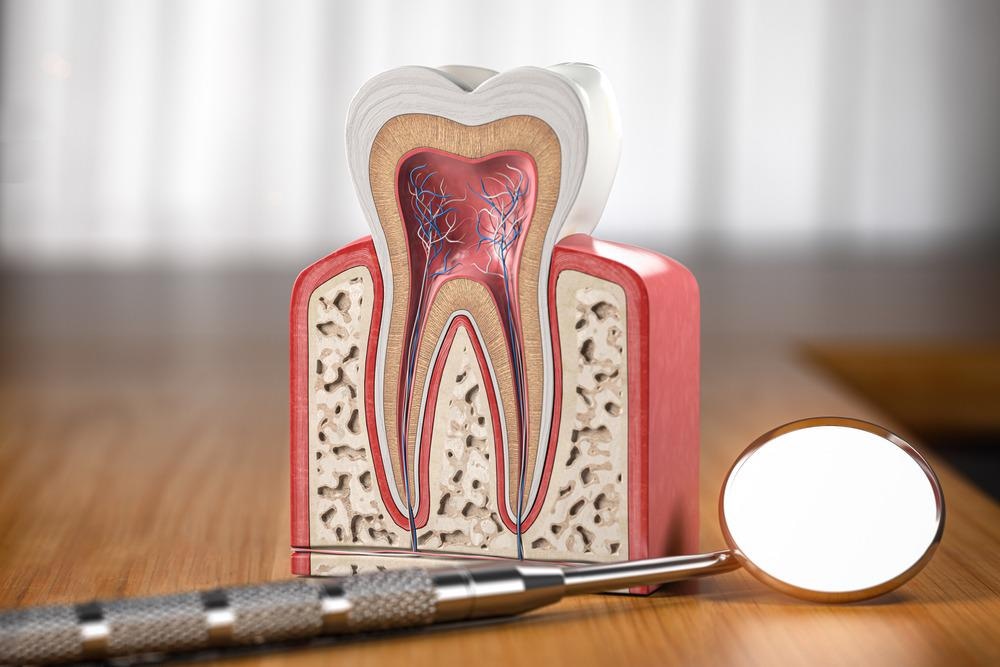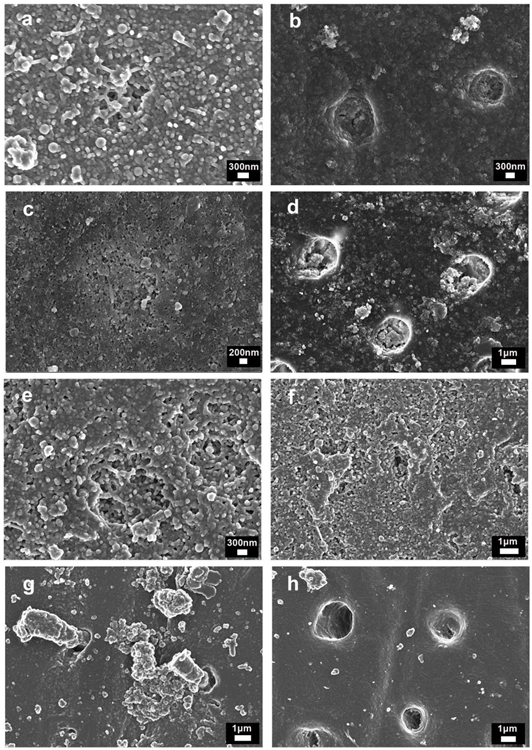An exciting development that focuses on polymeric zinc-doped nanoparticles could be the answer to solve dental hypersensitivity. The research published in the journal Nanomaterials aimed to assess the success of toothpastes, or dentifrices containing zinc to achieve durable tubule occlusion and aid dentin’s mechanical properties to prevent dental hypersensitivity.

Study: Novel Pastes Containing Polymeric Nanoparticles for Dentin Hypersensitivity Treatment: An In Vitro Study - Image Credit: Shutterstock
Previous Research
This area of biomaterials has already been spearheaded with other novel, innovative materials such as bioactive glass to treat dental hypersensitivity (DH). These materials aim to promote calcium and phosphate deposition on an inert scaffold to reduce DH; however, while this is an innovative solution, bioactive glass compositions for toothpaste formulations seem to lead to short-term tubule occlusion.
These investigations hope to overcome such drawbacks by utilizing polymeric nanoparticles, highlighting the necessity of innovative nanotechnology research to solve a common, ubiquitous problem.
The Need for Innovative Research
With the increase in health and dental strategies, there has been a reduction of dental concerns such as teeth decay. However, this has caused the level of non-carious dental health conditions to have risen. In Europe, the prevalence of non-carious dental lesions is high amongst 18-35 years old, where 42% of the population are affected by dental hypersensitivity.
The clinical definition of dental hypersensitivity includes a non-spontaneous, localized, but intense pain for a short period of time when a stimulus is present, which then ceases when the stimulus is removed.
The histopathological origin of DH can be seen to be from the hydrodynamic theory. Here, DH is characterized by a stimulus-induced fluid flow inside the dentinal tubules and the subsequent nociceptor activation at the dentino-pulpal space. This illustrates the importance of enamel as with this layer being stripped, the dentin is exposed, and dental hypersensitivity can occur with further dentinal tubule exposure.
Critical research surrounding dentin remineralization and tubule occlusion for DH treatment is significant, and this novel research utilizing polymeric nanoparticles is a promising candidate for solving this problem.

AFM images of the dentin surfaces after EDTA treatment and: (a) being brushed with distilled water and (b) after-treated with citric acid; (c) being brushed with toothpaste containing 1% of Zn-NPs and (d) after-treated with citric acid; (e) being brushed with toothpaste containing 5% of Zn-NPs and (f) after-treated with citric acid; (g) being brushed with toothpaste containing 10% of Zn-NPs and (h) after-treated with citric acid; and (i) being brushed with Sensodyne® toothpaste and (j) after-treated with citric acid. Scan size is 15 μm × 15 μm. Image Credit: Toledano-Osorio, M., et al
Fabricating Zinc-Doped Polymeric Nanoparticles
The polymeric nanoparticles were fabricated through a polymerization precipitation method, where a thermodynamic approach was used through the Flory-Huggins Model, and polymeric chains were produced through hydrogen-bonding, dispersion, and polar forces.
These nanoparticles consisted of a 2-hydroxyethyl methacrylate, methacrylic acid, and ethylene glycol dimethacrylate used as a cross-linker.
The functionalization of the nanoparticles through zinc-doping to create zinc nanoparticles (Zn-NPs) was enabled by immersing these particles in an aqueous solution of zinc chloride (ZnCl2) for three days under continuous shaking while at room temperature to allow optimum adsorption of the metal ion.

Nano-DMA mapping of the EDTA-treated dentin surfaces, after the following the treatments: (a) brushed with distilled water and (b) after-treated with citric acid; (c) brushed with toothpaste containing 1% of Zn-NPs and (d) after-treated with citric acid; (e) brushed with toothpaste containing 5% of Zn-NPs and (f) after-treated with citric acid; (g) brushed with toothpaste containing 10% of Zn-NPs and (h) after treated with citric acid; and (i) brushed with Sensodyne® toothpaste and (j) after treated with citric acid. The pixel data array for the mapping is organized according to the complex modulus distribution that concurs with a clear delimitation between intertubular and peritubular dentin. For the color scheme shown, the red color corresponds to the highest value of the locally measured complex modulus (E*), likely corresponding to the highest resistance to deformation and potentially associated with mineral precipitation. In most of the cases, it corresponds to intratubular locations (asterisks). Scale bars are in GPa. Scan size is 15 μm × 15 μm. Image Credit: Toledano-Osorio, M., et al
Significance of Novel Research
The researchers obtained 15 non-carious human third molars from donors from an age group of 18-25 years old, where the teeth were sectioned and processed to expose the dentinal tubules. The disks were then brushed with the experimental pastes, which consisted of three different kinds of toothpaste containing 1, 5, and 10% wt% Zn-doped nanoparticles; this was compared to a control of Sensodyne Repair and Protect as well as a group that was brushed with distilled water.
This potentially revolutionary research was found to create deposits and produce occluding tubules from just one application.
Although this result can be seen with some current desensitizing toothpaste containing compounds that can occlude the openings of dentinal tubules, creating a smear-like layer that can produce tubule plugs, this seems to only be a temporary fix.
Smear-like coating in this manner can be vulnerable to dissolution through acids or saliva as well as being removed through further brushing or other abrasive substances.
However, the innovative addition of polymeric zinc-doped nanoparticles within dentifrices has resulted in being confidently resistant to citric acid. This result also includes Sensodyne treated specimens, which caused 30% of newly opened tubules after citric acid application.
The research team found that while experimenting with different concentrations of nanoparticles, only 1 wt% of nanoparticles were required to produce the targeted effect of occluding tubules through its ability to be lodged into these tubules during brushing, a benefit of their nano-scale size.

FESEM images of the dentin surfaces after EDTA-treatment and: (a) brushed with distilled water and (b) after-treated with citric acid; (c) brushed with toothpaste containing 1% of Zn-NPs and (d) after-treated with citric acid; (e) brushed with toothpaste containing 5% of Zn-NPs and (f) after-treated with citric acid; (g) brushed with toothpaste containing 10% of Zn-NPs, and (h) after-treated with citric acid; and (i) brushed with Sensodyne® toothpaste and (j) after-treated with citric acid. All images are taken at 2500× magnification. Image Credit: Toledano-Osorio, M., et al
The Future of Pain Relief from Dental Hypersensitivity
With a correlation of having exposed dentinal tubules and dental hypersensitivity, clinical studies are required to prove the relief of DH symptoms through polymeric zinc-doped nanoparticles.
These results could be the start of a promising journey into relieving dental pain and revolutionizing dental health strategies, as well as exciting implications in the biomaterial world.
Though limited to in vitro evidence, it paves the way for in vivo experiments that could lead to concrete methods to reduce oral pain, targeting and decreasing dental erosive lesions.
The implications of this research can lead to advanced translatory dental hygiene products, including zinc nanoparticles within mouthwashes, that could aid the fight against dental diseases such as gingivitis.
Taking advantage of this research to advance oral health would be revolutionary for the nanotechnology industry, which continues to provide exciting innovations for various industries.

FESEM images of the dentin surfaces after EDTA-treatment and: (a) brushed with toothpaste containing 1% of Zn-NPs, where a single tubule occluded by NPs and new mineral formations were visible; (b) brushed with toothpaste containing 1% of Zn-NPs, for which occluded tubules were observed after acid application. Intertubular dentin was also covered by NPs and new minerals; (c) brushed with toothpaste containing 5% of Zn-NPs. A dentinal tubule occluded by NPs and new mineral formations were detected; (d) brushed with toothpaste containing 5% of Zn-NPs and after-treated with citric acid. Occluded and partially filled tubules are shown. Intertubular dentin was remineralized; (e) brushed with toothpaste containing 10% of Zn-NPs. Filled tubules and intertubular dentin covered by NPs and new minerals; (f) brushed with toothpaste containing 10% of Zn-NPs and after-treated with citric acid. A tiny tubule (about 250 nm) orifice was detectable on the dentin surface; (g) brushed with Sensodyne® toothpaste, where tubules were occluded by smear plugs, which were dislodged from the main dentinal orifice; (h) brushed with Sensodyne® toothpaste and after-treated with citric acid, for which intertubular dentin was demineralized and collagen fibers were observable. Image Credit: Image Credit: Toledano-Osorio, M., et al
Continue reading: Analyzing Novel Orthodontic Composite Resins with Nanoparticles for Antibacterial Properties.
Further Reading
Toledano-Osorio, M., Osorio, R., Osorio, E., Medina-Castillo, A.L., Toledano, M. (2021) Novel Pastes Containing Polymeric Nanoparticles for Dentin Hypersensitivity Treatment: An In Vitro Study. Nanomaterials, 11, 3150. Available at: https://www.mdpi.com/2079-4991/11/11/3150
Disclaimer: The views expressed here are those of the author expressed in their private capacity and do not necessarily represent the views of AZoM.com Limited T/A AZoNetwork the owner and operator of this website. This disclaimer forms part of the Terms and conditions of use of this website.